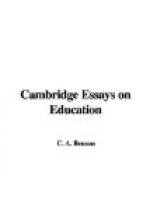But the child’s interest in things is social. Through the primitive occupations of mankind, he is entering step by step into the heritage of the race and into a richer fuller personal experience. The science which enlists a child’s interest is not that which is presented from the logical, abstract point of view. The way in which the child acquires it is the same as that in which mankind acquired it—his occupation presents certain difficulties, to overcome these difficulties he has to exercise his thought, he invents and experiments; and so thought reacts upon occupation, occupation reacts upon thought. And out of that reciprocal action science is born. In the same way his play is social—in his games too he enters into the heritage of the race, and in playing them he is learning unconsciously the greatest of all arts, the art of living with others. In his play as well as in his school work the lines of his natural development show how he can be trained to co-operate with the law of human progress.
This fitness and readiness to co-operate with the great movement of human progress, all-round fitness of body, mind and spirit, provides the formula which fuses and reconciles two growing tendencies in modern education.
There is in the first place the movement towards self-expression and self-development—postulating for the scholar a larger measure of liberty in thought and action, and self-direction than hitherto—this movement is represented mainly by Dr Montessori, and by “What is and what might be”; it is a movement which is spreading upwards from the infant school to the higher standards. Side by side with it is the movement towards the fuller development of corporate life in the school, the movement which trains the child to put the school first in his thoughts, to live for the society to which he belongs and find his own personal well-being in the well-being of that society. This has been, ever since Arnold, sedulously fostered in the games of the public schools, and fruitful of good results in that limited sphere; it has been applied with conspicuous success to the development of self-government, and it has reached its fullest expression in the little Commonwealth of Mr Homer Lane. But we are beginning to recognise its wider applications, it is capable of transforming the spirit of the class-room activities as well as the activities of a playing field, it is in every way as applicable to the elementary school as to Eton, or Rugby, or Harrow, and to girls as well as to boys.




